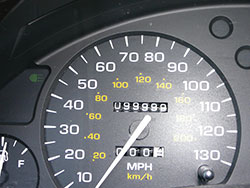 An odometer reading is reported as either the true or not true mileage for the vehicle.
An odometer reading is reported as either the true or not true mileage for the vehicle.
Odometer brands on vehicle titles may show up when at some point the vehicle’s odometer reading is known or suspected to not be the vehicle’s true mileage, due to tampering.
The Texas Department of Motor Vehicles provides the information below and in the following document to enable motorists to learn more about odometer fraud and what to watch for when purchasing a vehicle.
| NMVTIS Brand | Description | Texas Brand |
|---|---|---|
| Actual | The mileage is true for the vehicle. | Actual Mileage |
| Not Actual | The odometer reading is known to be other than the true mileage for the vehicle. | Not Actual Mileage |
| Not Actual - Odometer Tampering Verified | The odometer reading is known to be other than true mileage for the vehicle, due to tampering | Not Actual Mileage |
| Exempt from Odometer Disclosure | The vehicle falls within criteria that allow it to change ownership without disclosure of the odometer reading. | Exempt |
| Exceeds Mechanical Limits | The odometer reading is less than the true mileage of the vehicle because the odometer cannot display the total number of true miles. | Mileage Exceeds Mechanical Limits |
| Odometer May Be Altered | The titling authority has reason to believe that the odometer reading does not reflect the true mileage of the vehicle because of an alteration to the odometer. | Not Actual Mileage |
| Odometer Replaced | Odometer in the vehicle is not the one put in the vehicle when manufactured. | Not Actual Mileage |
| Odometer Discrepancy | The titling authority has reason to believe that the odometer reading does not reflect the true mileage of the vehicle because of known previous recorded values for the vehicle. | Not Actual Mileage |
| Call Title Division | The titling authority knows of some problem with the odometer reading that it cannot print on a title. Titling authority will discuss the problem with authorized inquirers. | N/A |
It can be difficult, but not impossible to detect when a vehicle's odometer has been altered.
- Ask to see the vehicle's title and compare the mileage listed on it with the value on the odometer. Inspect the title closely if the mileage notation seems obscured or is hard to read.
- Compare the mileage on the odometer with the mileage reported on the vehicle's maintenance or inspection records. When possible, also check the mileage listed on oil-change and maintenance stickers. These stickers can be found on windows or door frames, in the glove box, or under the hood.
- If the vehicle has a traditional mechanical odometer, check that the numbers on the odometer gauge are aligned correctly. If these numbers are crooked, contain gaps, or jiggle when you hit the dash with your hand, the vehicle may have been subjected to odometer tampering.
- Inspect the tires and measure the depth of the tread. If the odometer reads 20,000 or less miles, the vehicle should still have the original tires.
- Look at the wear and tear on the vehicle – especially the gas, brake and clutch pedals – to see if the wear seems consistent with and appropriate for the number of miles displayed on the odometer.
